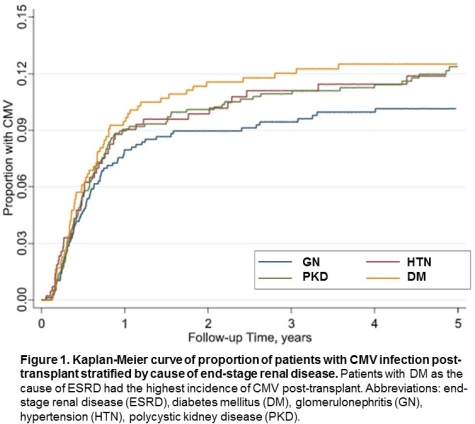Cause of ESRD is Not Associated with Risk of Post-Transplant CMV Infection
S. Panzer, S. Peery, B. Astor, A. Djamali, T. Singh.
University of Wisconsin Madison, Madison, WI.
Meeting: 2018 American Transplant Congress
Abstract number: A173
Keywords: Cytomeglovirus, Infection, Kidney transplantation
Session Information
Session Name: Poster Session A: Kidney Transplant Goes Viral
Session Type: Poster Session
Date: Saturday, June 2, 2018
Session Time: 5:30pm-7:30pm
 Presentation Time: 5:30pm-7:30pm
Presentation Time: 5:30pm-7:30pm
Location: Hall 4EF
Purpose: Cytomegalovirus (CMV) infection is commonly encountered following kidney transplantation and is associated with patient morbidity and mortality. While preventative pharmacotherapy is used to prevent CMV re-activation, its utility is limited due to medication side effects and high cost. Thus, there is a need to identify which patients are at greatest risk of CMV infection. Whether the cause of end-stage renal disease (ESRD) influences the risk of developing CMV infection post-transplant is unclear.
Methods: We analyzed data from 2,741 adult kidney transplant recipients from January 1993 through December 2014. The causes of ESRD in kidney transplant recipients included diabetes mellitus (DM, N=947), hypertension (HTN, N=442), polycystic kidney disease (PKD, N=549), or glomerulonephritis (GN, N= 803). The primary outcome was incidence of CMV viremia, defined as the first episode of positive serum CMV test following transplant.
Results: Three hundred and thirty patients developed CMV viremia over a median follow up time of 4.5 years. There were no differences in induction regimen between the groups. Patients with DM as the cause of ESRD had a higher incidence rate of CMV viremia post-transplant compared to those with GN (2.37 versus 1.58 per 100 person-years, P < 0.005). Incidence rates for HTN and PKD were 2.17 and 2.07 per 100 person-years, respectively.  DM was associated with a 35% higher risk of CMV infection compared to GN in unadjusted analyses [HR=1.35 (95% CI 1.02-1.78), P=0.04]. Adjustment for age, however, attenuated the association [DM: age-adjusted HR 1.02 (0.78-1.39); HTN: aHR=0.96 (0.67-1.36); PKD: aHR=1.08 (0.78-1.48); compared to GN]. Subgroup analysis of high-risk patients, donor positive to recipient negative serostatus, revealed no differences in the incidence rate of CMV infection among the groups (DM=4.56, HTN=5.78, PKD=4.23, and GN=3.28 per 100 person-years).
DM was associated with a 35% higher risk of CMV infection compared to GN in unadjusted analyses [HR=1.35 (95% CI 1.02-1.78), P=0.04]. Adjustment for age, however, attenuated the association [DM: age-adjusted HR 1.02 (0.78-1.39); HTN: aHR=0.96 (0.67-1.36); PKD: aHR=1.08 (0.78-1.48); compared to GN]. Subgroup analysis of high-risk patients, donor positive to recipient negative serostatus, revealed no differences in the incidence rate of CMV infection among the groups (DM=4.56, HTN=5.78, PKD=4.23, and GN=3.28 per 100 person-years).
Conclusions: DM patients have a higher incidence of CMV viremia than GN patients. However, the higher incidence is related to the advanced age of the DM group. The cause of ESRD is not a significant factor in the risk of CMV infection post-transplant in kidney transplant recipients.
CITATION INFORMATION: Panzer S., Peery S., Astor B., Djamali A., Singh T. Cause of ESRD is Not Associated with Risk of Post-Transplant CMV Infection Am J Transplant. 2017;17 (suppl 3).
To cite this abstract in AMA style:
Panzer S, Peery S, Astor B, Djamali A, Singh T. Cause of ESRD is Not Associated with Risk of Post-Transplant CMV Infection [abstract]. https://atcmeetingabstracts.com/abstract/cause-of-esrd-is-not-associated-with-risk-of-post-transplant-cmv-infection/. Accessed December 16, 2025.« Back to 2018 American Transplant Congress
